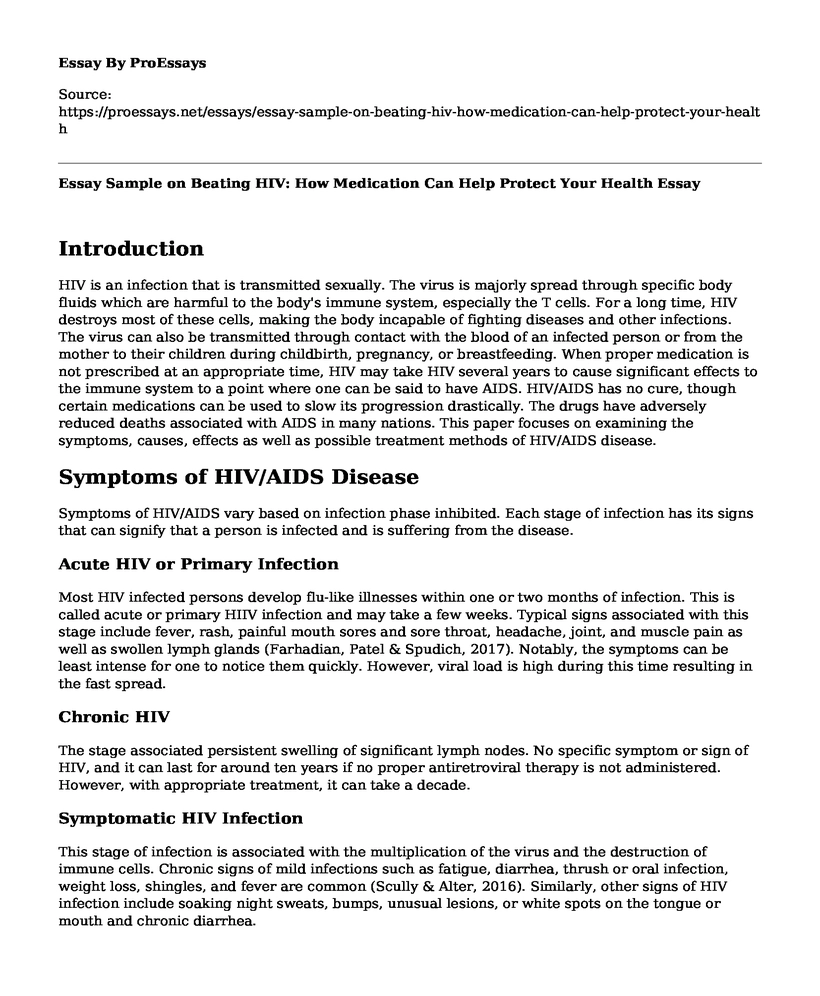Introduction
HIV is an infection that is transmitted sexually. The virus is majorly spread through specific body fluids which are harmful to the body's immune system, especially the T cells. For a long time, HIV destroys most of these cells, making the body incapable of fighting diseases and other infections. The virus can also be transmitted through contact with the blood of an infected person or from the mother to their children during childbirth, pregnancy, or breastfeeding. When proper medication is not prescribed at an appropriate time, HIV may take HIV several years to cause significant effects to the immune system to a point where one can be said to have AIDS. HIV/AIDS has no cure, though certain medications can be used to slow its progression drastically. The drugs have adversely reduced deaths associated with AIDS in many nations. This paper focuses on examining the symptoms, causes, effects as well as possible treatment methods of HIV/AIDS disease.
Symptoms of HIV/AIDS Disease
Symptoms of HIV/AIDS vary based on infection phase inhibited. Each stage of infection has its signs that can signify that a person is infected and is suffering from the disease.
Acute HIV or Primary Infection
Most HIV infected persons develop flu-like illnesses within one or two months of infection. This is called acute or primary HIIV infection and may take a few weeks. Typical signs associated with this stage include fever, rash, painful mouth sores and sore throat, headache, joint, and muscle pain as well as swollen lymph glands (Farhadian, Patel & Spudich, 2017). Notably, the symptoms can be least intense for one to notice them quickly. However, viral load is high during this time resulting in the fast spread.
Chronic HIV
The stage associated persistent swelling of significant lymph nodes. No specific symptom or sign of HIV, and it can last for around ten years if no proper antiretroviral therapy is not administered. However, with appropriate treatment, it can take a decade.
Symptomatic HIV Infection
This stage of infection is associated with the multiplication of the virus and the destruction of immune cells. Chronic signs of mild infections such as fatigue, diarrhea, thrush or oral infection, weight loss, shingles, and fever are common (Scully & Alter, 2016). Similarly, other signs of HIV infection include soaking night sweats, bumps, unusual lesions, or white spots on the tongue or mouth and chronic diarrhea.
Causes of HIV Disease
A virus causes the disease. HIV spreads through unprotected sexual contact, unscreened blood transfusion, or from mother to baby during breastfeeding, childbirth, or pregnancy. HIV causes massive destruction to the CD4 T cells that are useful for fighting against diseases. Notably, HIV infection can take several years before turning into AIDs.
Complications
HIV disease weakens an individual's immune system making them vulnerable to other infections such as tuberculosis (TB), candidiasis, toxoplasmosis, Cryptococci meningitis, cryptosporidiosis, and cytomegalovirus (Farhadian, Patel & Spudich, 2017). The consequential impacts of these infections render the body passive and easily threatened and may lead to death. Significantly, they massively lower the body's immune system leading to exposure to cancer infections or complications. Other complications, such as neurological and wasting syndrome, are common in HIV disease.
Prevention of HIV
To prevent HIV disease spread, people are advised to use new condoms during the time of sex. However, if lubricants are chosen, it is advisable to use water-based because they cannot weaken condoms. Use of clean needles during injections and piercing helps prevent HIV spread. The needles must be sterilized before use. Overall, consideration of male circumcision has been seen as a means of reducing a man's risk of being infected with HIV.
References
Farhadian, S., Patel, P., & Spudich, S. (2017). Neurological complications of HIV infection. Current infectious disease reports, 19(12), 50. Doi: 10.1007/s11908-017-0606-5
Scully, E., & Alter, G. (2016). NK cells in HIV disease. Current HIV/AIDS Reports, 13(2), 85-94. Doi: 10.1007/s11904-016-0310-3.
Cite this page
Essay Sample on Beating HIV: How Medication Can Help Protect Your Health. (2023, Feb 12). Retrieved from https://proessays.net/essays/essay-sample-on-beating-hiv-how-medication-can-help-protect-your-health
If you are the original author of this essay and no longer wish to have it published on the ProEssays website, please click below to request its removal:
- Essay on Nursing: Registered Nurse Licensed Practical and Licensed Vocational Nurses
- Essay Sample on Epidemiology
- Essay Sample on State Nursing Boards Empowering Competent Practices Across US States
- Research Paper on Health People 2020: Reducing Type 2 Diabetes in the Hispanic Community
- Research Paper on UK Welfare State: Quality Healthcare, Social Security & Education
- COVID-19: From First Cases in China to Global Pandemic - Essay Sample
- Free Paper Example on Living with Multiple Sclerosis: A Complex Disorder







